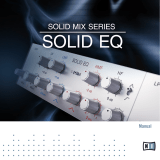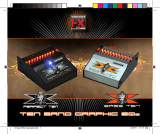
- 6 -
• English
V. 1.0LUCAS NANO REMOTE – Manual
Good to know:
If you wish to unmute the Master channel, but do not have an iPad
connected, simply give the Master volume knob on the NANO 608i
a quick turn. This also unmutes all channels.
Current Scene Name
03* The Chickenfields - Pub Line Up
This panel shows the memory slot number and the name of the
currently loaded scene at the top center of the screen. An asterisk
in front of the name indicates that the scene has been edited, but
not saved..
See the section entitled Scenes later in this chapter.
Nano Status
The Nano Status icon indicates if the NANO 608i is operating in
stereo or mono mode. The little diagram shows a stereo satellite
or a satellite array, depending on the position of the Setup switch
on the NANO 608i. This icon is there for informational purposes
only; you can’t use it to remotely switch the setup.
• This indicator also tells if you the NANO 608i’s Link port is in use;
that is, if two NANO 608i systems connected via a link cable and
confi gured in a Twin Stereo setup.
Good to know:
If you wish to confi gure two LUCAS NANO 608i systems in a Twin
Stereo setup, be sure to assign each NANO 608i to a side (left or
right) using its Balance knob. For more on this, consult the "Link
In/Out" section in the NANO 608i manual. The app’s balance
control is automatically deactivated in this mode to prevent
handling errors.
Bluetooth Signal Strength
A fi ve-segment segment indicator tells you the strength of the
signal connecting the NANO 608i and iPad. It looks and works just
like the indicators on smartphones.
• It gives you a visual indication as to the quality of communication
between devices. If the connection is poor, you can try moving
the NANO 608i or iPad a little this way or that to get a stronger,
more stable signal.
Read chapter 10 to learn more about the Bluetooth connection.
Scenes
SCENES
Tapping the Scenes button opens a menu that serves to manage
mixer scenes. A scene contains all settings on the Mixer page
(Channel Fader, Mute, Names and Photos), all settings on the
individual Channel pages (Contour, Rev Send, Low Cut, EQ and
Compressor), the Reverb preset and the Master EQ on the Master
page.
The Master Volume, Sub and Balance settings on the Master
page are not stored with a scene. These settings generally vary
with each event and venue, which is why you don’t want a scene
overriding your settings and changing the system’s sound.
You can determine if the app will load the Master EQ setting of a
scene using the Ignore Master EQ in Scenes option in the Setup
menu. See chapter 9, Setup Menu, for more on this. This option
comes in handy when you don’t want the Master EQ settings
stored with the scene to override your current Master EQ settings.
The app only loads Easy scenes in Easy mode and only Expert
scenes in Expert mode. You can see the other mode’s scenes, but
they are grayed out and cannot be selected. If you wish to select a
grayed-out scene, you will have to change the mode in the Setup
menu. For more on this, see Chapter 9, Setup Menu.
Default Scene
-
ModeScene Name
Scene Memory
No.
000
Irish Pub Trio
Easy
001
Sports Bar - Birthday Joe002
The Chickenfields - Pub Line Up Expert003*
Recording during rehearsals Expert004
Sue’s Classical Easy005
Mary’s wedding party Expert006
2 mic./ 2 guit. Songwriter contest007
Rehearsal room default008
LOAD SAVE... DELETE SHARE
*modified
Date
09.02.16, 17:54
27.09.15, 22:02
15.08.15, 19:20
12.01.16, 21:08
17.03.16, 21:08
Expert
03.02.16, 09:18
Expert
06.03.16, 19:02
28.10.15, 11:56
SELECT
The panels shows the loaded scene’s name at the top in the
header. The asterisk in front of the name indicates that the current
scene has been edited, but the changes have yet to be saved. This
is also indicated by the term “*modifi ed” appearing at the bottom
left above the Load button.
• Tap No. to sort the scenes by number, Name by name, and Date
by date. The Mode column indicates the mode in which the scene
was created, Easy or Expert. You can also sort scenes by mode.
The yellow line indicates the currently loaded scene. The currently
selected scene appears with a color backdrop or frame.
The app enables the action buttons at the bottom depending on
which scene you have loaded or selected:
• Tapping the Load button loads the selected scene.
• Use Save... to save the selected scene to the current position or
to a newly selected position.
• Delete erases the selected scene. A CAUTIONARY WORD: This
scene will be wiped out permanently, never to be retrieved.
• Use Share to manage and share the selected scene using the
usual iPad tools. The iPad has be connected to the Internet to
share scenes.
• The Select button lets you select several scenes at once to
execute the same action for all.
• If you want to rename a scene, press and hold its name to open
the Rename menu.
4 The Mixer Page

























